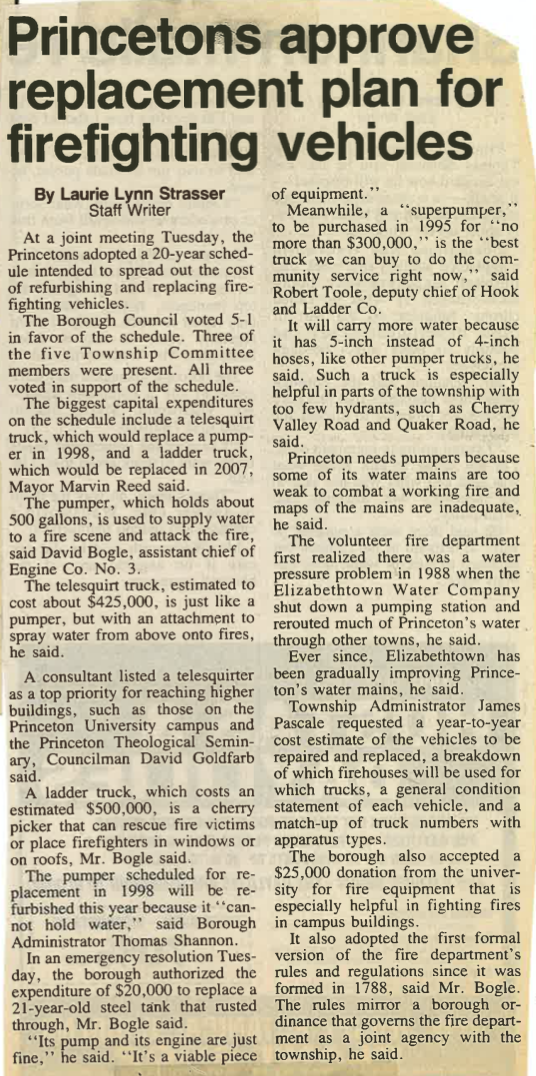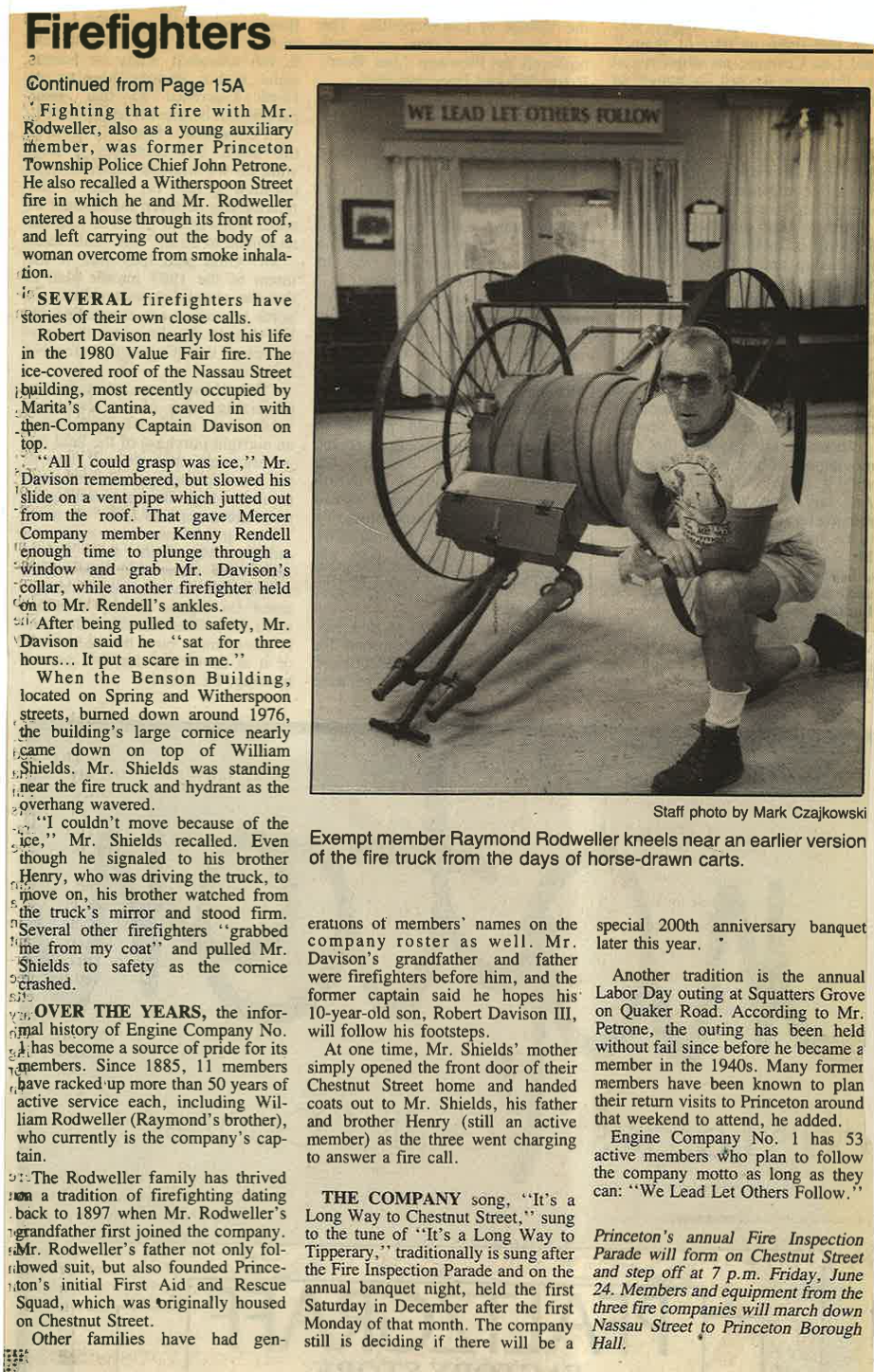
June 13, 1994 (~estimated)
Princetons approve replacement plan for firefighting vehicles
By Laurie Lynn Strasser
Staff Writer
At a joint meeting Tuesday, the Princetons adopted a 20-year schedule intended to spread out the cost of refurbishing and replacing fire-fighting vehicles.
The Borough Council voted 5-1 in favor of the schedule. Three of the five Township Committee members were present. All three voted in support of the schedule.
The biggest capital expenditures on the schedule include a telesquirt truck, which would replace a pump-er in 1998, and a ladder truck, which would be replaced in 2007, Mayor Marvin Reed said.
The pumper, which holds about 500 gallons, is used to supply water to a fire scene and attack the fire, said David Bogle, assistant chief of Engine Co. No. 3.
The telesquirt truck, estimated to cost about $425,000, is just like a pumper, but with an attachment to spray water from above onto fires, he said.
A consultant listed a telesquirter as a top priority for reaching higher buildings, such as those on the Princeton University campus and the Princeton Theological Seminary, Councilman David Goldfarb said.
A ladder truck, which costs an estimated $500,000, is a cherry picker that can rescue fire victims or place firefighters in windows or on roofs, Mr. Bogle said.
The pumper scheduled for replacement in 1998 will be re-furbished this year because it “cannot hold water,” said Borough Administrator Thomas Shannon.
In an emergency resolution Tuesday, the borough authorized the expenditure of $20,000 to replace a 21-year-old steel tank that rusted through, Mr. Bogle said.
“Its pump and its engine are just fine,” he said. “It’s a viable piece of equipment.”
Meanwhile, a “superpumper,” to be purchased in 1995 for “no more than $300,000,” is the “best truck we can buy to do the community service right now,” said Robert Toole, deputy chief of Hook and Ladder Co.
It will carry more water because it has 5-inch instead of 4-inch hoses, like other pumper trucks, he said. Such a truck is especially helpful in parts of the township with too few hydrants, such as Cherry Valley Road and Quaker Road, he said.
Princeton needs pumpers because some of its water mains are too weak to combat a working fire and maps of the mains are inadequate, he said.
The volunteer fire department first realized there was a water pressure problem in 1988 when the Elizabethtown Water Company shut down a pumping station and rerouted much of Princeton’s water through other towns, he said.
Ever since, Elizabethtown has been gradually improving Prince-ton’s water mains, he said.
Township Administrator James Pascale requested a year-to-year cost estimate of the vehicles to be repaired and replaced, a breakdown of which firehouses will be used for which trucks, a general condition statement of each vehicle, and a match-up of truck numbers with apparatus types.
The borough also accepted a $25,000 donation from the university for fire equipment that is especially helpful in fighting fires in campus buildings.
It also adopted the first formal version of the fire department’s rules and regulations since it was formed in 1788, said Mr. Bogle. The rules mirror a borough ordinance that governs the fire department as a joint agency with the township, he said.

Fighting that fire with Mr. Rodweller, also as a young auxiliary member, was former Princeton Township Police Chief John Petrone. He also recalled a Witherspoon Street fire in which he and Mr. Rodweller entered a house through its front roof, and left carrying out the body of a woman overcome from smoke inhalation.
SEVERAL firefighters have stories of their own close calls.
Robert Davison nearly lost his life in the 1980 Value Fair fire. The ice-covered roof of the Nassau Street building, most recently occupied by Marita’s Cantina, caved in with then-Company Captain Davison on top. I
“All I could grasp was ice,” Mr. Davison remembered, but slowed his ‘slide on a vent pipe which jutted out from the roof. That gave Mercer Company member Kenny Rendell enough time to plunge through a window and grab Mr. Davison’s collar, while another firefighter held on to Mr. Rendell’s ankles.
After being pulled to safety, Mr. Davison said he “sat for three hours… It put a scare in me.”
When the Benson Building, located on Spring and Witherspoon streets, burned down around 1976, the building’s large cornice nearly came down on top of William shields. Mr. Shields was standing near the fire truck and hydrant as the overhang wavered.
“I couldn’t move because of the ice,” Mr. Shields recalled. Even “though he signaled to his brother Henry, who was driving the truck, to move on, his brother watched from the truck’s mirror and stood firm. Several other firefighters “grabbed me from my coat” and pulled Mr. Shields to safety as the cornice crashed.
OVER THE YEARS, the informal history of Engine Company No. 1 has become a source of pride for its members. Since 1885, 11 members have racked-up more than 50 years of active service each, including William Rodweller (Raymond’s brother), who currently is the company’s captain.
The Rodweller family has thrived on a tradition of firefighting dating back to 1897 when Mr. Rodweller’s grandfather first joined the company. Rodweller’s father not only followed suit, but also founded Princeton’s initial First Aid and Rescue Squad, which was originally housed on Chestnut Street.
Other families have had generations of members’ names on the company roster as well. Mr. Davison’s grandfather and father were firefighters before him, and the former captain said he hopes his 10-year-old son, Robert Davison III, will follow his footsteps.
At one time, Mr. Shields’ mother simply opened the front door of their Chestnut Street home and handed coats out to Mr. Shields, his father and brother Henry (still an active member) as the three went charging to answer a fire call.
THE COMPANY song, “It’s a Long Way to Chestnut Street,” sung to the tune of “It’s a Long Way to Tipperary,” traditionally is sung after the Fire Inspection Parade and on the annual banquet night, held the first Saturday in December after the first Monday of that month. The company still is deciding if there will be a special 200th anniversary banquet later this year.
Another tradition is the annual Labor Day outing at Squatters Grove on Quaker Road. According to Mr. Petrone, the outing has been held without fail since before he became a member in the 1940s. Many former members have been known to plan their return visits to Princeton around that weekend to attend, he added.
Engine Company No. 1 has 53 active members who plan to follow the company motto as long as they can: “We Lead Let Others Follow.”
Princeton’s annual Fire Inspection Parade will form on Chestnut Street and step off at 7 p.m. Friday. June 24. Members and equipment from the three fire companies will march down Nassau Street o Princeton Borough Hall.